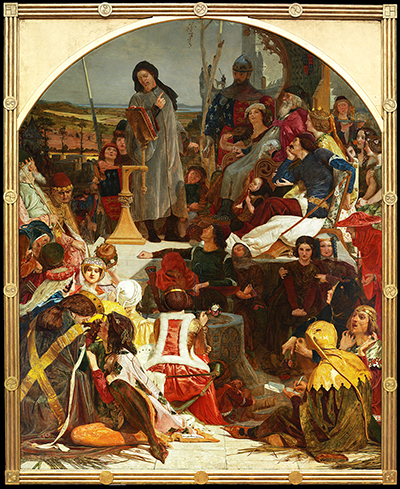The painting, Chaucer at the Court of Edward III, is an oil on canvas and was done between 1847 and 1851. Its genre is that of History Painting and was done during the period of the Pre Raphaelite Brotherhood. It's important to note that the paint is a replica of a much larger original exhibited in 1851.
This painting depicts several figures that although closely packed, most of them can be identified. To the right of the Chaucer, is John of Gaunt, and seated nearby under the canopy is Edward III, with his mistress between them. There is also a little boy between the Kings and the Chaucers feet who is the future Richard II. Among other notable figures is Froissart, who is seated in the right foreground and is taking notes. An important aspect worth noting in Chaucer at the Court of Edward III is how the light was used in the paint. It is coming from a natural source, the sun, as the scene is taking place in open-air. This was Madox first attempted to carry out the notion of treating natural sunlight and its shade absolutely, as it exists at any given moment, instead of approximation or a generalized style.
The painting has been done on pure colors and the contours are so clear on a white ground, and the subjects are full of life. There is a sense of pageantry in the paint work. The texture is smooth, soft and polished. The mood is thought-provoking, energetic and relaxed. Ford Madox Brown was greatly inspired by several people including Peter Von Cornelius. He met Peter Cornelius during his visit to Italy in 1845. He influenced Brown especially in his style of painting and the palette.
He also adopted a bright color and the realistic style of painting from William Holman and John Everett Millais who were part of the Pre Raphaelite Brotherhood. Other figures who influenced Brown are Holbein and Friedrich Overbeck whom he met in Rome. Dante Gabriel Rosserri greatly admired Brown's work. Among Madox's famous works include The Last Of England (1852 to 1855), The Manchester Murals, Execution of Mary, Queen of Scots ( 1839 to 1841), Dr. Primrose and his Daughters in 1840 and The Prisoner of Chillon.




